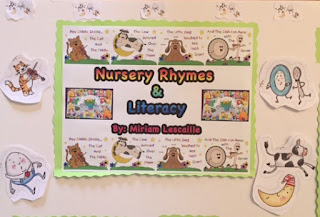Miriam Lescaille
LTD-606
Dr. Michelle Rosen
Module : 6
Due: 4-17-16
Articles:
“Using literacy
assessment results to improve teaching for English-language learners”
By: Lori A. Helman
“Assessing
preschoolers’ emergent literacy skills in English and Spanish with the Get
Ready to Read! Screening tool”
- On going assessment of early literacy progress is essential for giving teachers the information they need to measure students progress, identify students who may require additional or individualized assistance, and guide instructional practice (Helman, 2005).
- Results from early literacy assessments can help in four areas: Teachers and school personnel can pinpoint groups of students in need of additional support; They can provide instruction at students’ developmental levels; Educators can determine which literacy activities are difficult for individuals and groups of students; Finally, educators can identify students early and provide enriched learning opportunities that build on their background understandings (Helman, 2005).
- Screeners administered by teachers at the beginning of the preschool year to predict the oral language and phonological and print processing skills and their findings suggest that they can effectively be used to assess preschool children’s emergent literacy skills (Farver; Nakamoto; Lonigan, 2007).
- The results support the early use of screening measures to identify the children most at risk of later reading difficulties regardless of whether children are ELL or EO; Such screening may be used to guide additional in depth assessment to specify more clearly children’s areas of strengths and weakness in key domains, to guide selection of appropriate effective early intervention, or both (Farver et al., 2007).
- The assessment provides teachers with information about the educational progress of individual students, and points to possible areas of difficulty that might impede a student’s learning (Helman, 2005).
- Some, studies have shown that phonological awareness and reading skills are correlated in Spanish, and there seems to be a typical developmental sequence in phonological awareness across alphabetic languages such as Spanish (Farver et al., 2007).
- In a recent review of several predictive studies with ELL children, Klingner et al. (2006) concluded that factors were associated with later reading ability in English or a second language generally included phonological awareness and print/letter knowledge (Farver et al., 2007).
- Finally, interventions for first-and-second grade ELL children that included some form of phonological instruction, children made significant progress in later reading (Farver et al., 2007).
- Beginning readers whether Ells like Carlos and Rosita or Non Ells will profit from reading and rereading memorized text, print that contains known sight words, and text that features words with simple letter-sound correspondences (Helman, 2005).
- Beginning readers increase their phonics and phonemic awareness skills when given the opportunity to use developmental writing (Helman 2005).
Theme 3. Standardized
Assessment/Screening Tools for Literacy:
- PALS 1-3 (Phonological Awareness Literacy Screening 1-3) is a multilayered assessment that extends as needed to document the beginning literacy strengths of students first through-third-grade students: word recognition in isolation, developmental spelling, and oral reading in context (Helman, 2005).
TEACHER TUBE VIDEO - ON PALS:
- The PALS assessment has been used in K-3 classrooms across the country to measure reading progress and identify students in need of extra support (Helman, 2005).
- GRTR/ E-GRTR and S-GRTR (Get Ready to Read English and Spanish Versions) is administered at the beginning of the preschool year to predict the oral language and phonological and print processing skills of Spanish-speaking English-language learners (ELLs) and English-only speaking children (EO) at the end of the year and the findings suggest that both screeners can be used effectively to assess preschool children’s emergent literacy skills (Farver et al., 2007).
- The primary goal in developing the GRTR screener was to develop an instrument that could provide a brief and reliable assessment of preschoolers’ status in acquiring fundamental emergent literacy skills and which also had strong concurrent relations to lengthier measures with established validity in predicting reading skills (Farver et al., 2007).
- PALS 1-3 Assessment Literacy Screening and GRTR Screener for ELLs or EO preschool children are very effective to assess children’s emergent literacy skills (Helman, 2005 and Farver et al., 2007).
References
Farver, J. M., Nakamoto, J., & Lonigan, C. J. (2007). Assessing preschoolers’ emergent literacy skills in English and Spanish with the Get Ready to Read! screening tool. Annals of Dyslexia Ann. of Dyslexia, 57(2), 161-178. doi:10.1007/s11881-007-0007-9
Helman, L. A. (2005). Using Literacy Assessment Results to Improve Teaching for English-Language Learners. The Reading Teacher, 58(7), 668-677. doi:10.1598/rt.58.7.7
















































